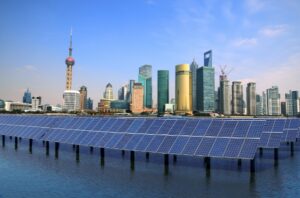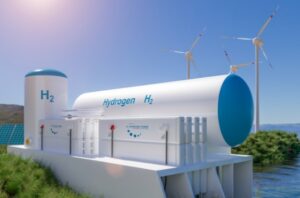The Hidden Costs of Renewable Energy
Author: Andrew Miller
Renewable energy is being touted as the main viable alternative energy source to fossil fuels as the world struggles to reign in greenhouse gas (GHG) emissions (IPCC). Unlike fossil fuels, renewables don’t emit GHGs when in operation, they don’t depend on a finite amount of resources, and they don’t contribute to other environmental issues such as air pollution. However, renewable energy is far from a silver bullet for all environmental issues. Many renewables cause severe environmental damage in their sourcing of materials, manufacturing, implementation, and disposal (UCS). The most abundant renewable energy sources; solar, wind, and hydropower all cause significant environmental damage that should not be overlooked as the world seeks to adopt them in our fight against climate change.
 Solar power is generated using structures known as solar panels. Solar panels harm the environment at almost all stages of their lives. Solar panels are made with minerals and rare earth elements including gallium, indium, and arsenic (USGS). These materials are extracted from the earth using destructive mining practices that contribute to habitat loss, water and soil pollution, and emit GHGs. Mining for rare earth minerals is even more destructive as most mines are found in biodiverse forests in the tropics (Asher). Solar panels also cover vast amounts of space, much more than fossil fuel infrastructure, and need to be sited in sunny locations, which can harm biodiversity by fragmenting habitat (Gross; UCS). Solar panel waste is a looming environmental catastrophe as recycling programs are not yet widespread, further promoting mining for essential materials, and panels leach toxic metals and chemicals into soil and groundwater (IRENA).
Solar power is generated using structures known as solar panels. Solar panels harm the environment at almost all stages of their lives. Solar panels are made with minerals and rare earth elements including gallium, indium, and arsenic (USGS). These materials are extracted from the earth using destructive mining practices that contribute to habitat loss, water and soil pollution, and emit GHGs. Mining for rare earth minerals is even more destructive as most mines are found in biodiverse forests in the tropics (Asher). Solar panels also cover vast amounts of space, much more than fossil fuel infrastructure, and need to be sited in sunny locations, which can harm biodiversity by fragmenting habitat (Gross; UCS). Solar panel waste is a looming environmental catastrophe as recycling programs are not yet widespread, further promoting mining for essential materials, and panels leach toxic metals and chemicals into soil and groundwater (IRENA).
Hydropower is even more destructive than solar power. Hydroelectric dams block rivers, disrupt the flow of water and sediments, and push native species towards extinction (Fendt). The accumulation and decomposition of organic matter in reservoirs behind dams also emits a significant amount of GHG emissions (Fendt; IHA). The construction of the dams themselves is environmentally harmful as they are mostly made of cement, a material that is very emissions intensive to produce (IHA). Hydropower is also becoming less reliable as many parts of the world are experiencing more frequent and intense droughts that are leading to water shortages that endanger power generation (Dilling et al.)

Wind is the less environmentally harmful than other mainstream renewable energy sources. Onshore wind has been criticised for disrupting migratory bird patterns, fragmenting terrestrial habitat (UCS). While offshore wind might be even more environmentally harmful for the threats it poses to marine life. The most concerning possible impacts include damage to benthic ecosystems, increased ship traffic, and increased noise pollution. But many of these impacts need to be investigated further to determine their severity (Bailey et al.). As with solar panels, wind turbines occupy a lot of land and are inflexible in where they can be sited (Gross). Wind turbines also utilises rare earth minerals in their generators, which as with solar panels, promotes unsustainable mining practices around the world (Asher; USGS).
Less conventional renewable energy sources such as biomass, geothermal, and hydrogen come at an environmental cost too. The carbon benefits of burning biomass for energy are marginal as razing large swaths of vegetated land to establish tree plantations or harvest a biomass crop emits GHGs, contributes to soil erosion, and pollutes water (Wu et al.). Geothermal energy requires a complex system of infrastructure and new methods that force open fissures in the earth’s crust have been linked to causing earthquakes (Garthwaite). Hydrogen fuel cells emit hydrogen, a secondary GHG, will still contribute to short term global warming and are still mostly powered by fossil fuels (Ocko and Hamburg).
Despite the environmental impacts of renewable energy, they are not justification to delay or stop transitioning away from fossil fuels.
The climatic benefits of renewable energy far outweigh the environmental costs (IPCC 2022).
It is crucial that renewable energy is implemented strategically and with consideration of biodiversity as soon as possible to replace fossil fuels. Unregulated development was what brought the world into the current climate crisis, it should not be part of the effort to bring us back to a stable world.
Sources:
Asher, Claire. “Climate Positive, High-Tech Metals are Polluting Earth, but Solutions Await.” Mongabay, 15 Mar. 2022. https://news.mongabay.com/2022/03/climate-positive-high-tech-metals-are-polluting-earth-but-solutions-await/. Accessed 29 Jul. 2022.
Bailey, Helen., Brookes, Kate L., Thompson, Paul M. “Assessing Environmental Impacts of Offshore Wind Farms: Lessons Learned and Recommendations for the Future.” Aquatic Biosystems vol. 10, no. 8, pp: https://doi.org/10.1186/2046-9063-10-8
“Critical Mineral Commodities in Renewable Energy.” United States Geological Survey. https://www.usgs.gov/media/images/critical-mineral-commodities-renewable-energy. Accessed 31 Jul. 2022.
“End-of-Life Management: Solar Photovoltaic Panels.” International Renewable Energy Agency, irena.org/-/media/Files/IRENA/Agency/Publication/2016/
IRENA_IEAPVPS_End-of-Life_Solar_PV_Panels_2016.pdf.
Accessed 1 Aug. 2022.
“Environmental Impacts of Wind Power.” Union of Concerned Scientists, https://www.ucsusa.org/resources/environmental-impacts-wind-power. Accessed 29 Jul. 2022.








